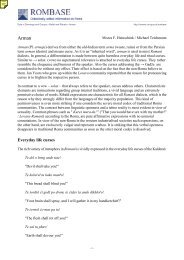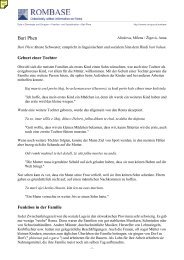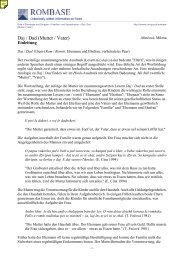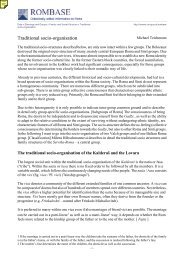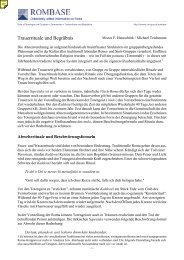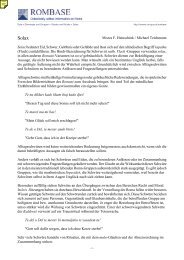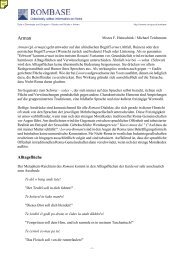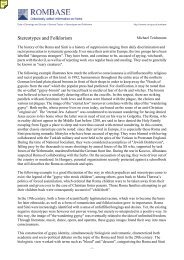Create successful ePaper yourself
Turn your PDF publications into a flip-book with our unique Google optimized e-Paper software.
Data » Ethnology and Groups » Family- and Social-Structure » <strong>Names</strong> <strong>of</strong><br />
<strong>Roma</strong><br />
<strong>Names</strong> <strong>of</strong> <strong>Roma</strong><br />
nav, m. (Ind.) – name<br />
Milena Hübschmannová<br />
In every human society one must somehow identify individual persons: men, women, children. The<br />
shortest and most basic identification is their names. Among Slovak <strong>Roma</strong> three types <strong>of</strong> basic names<br />
are used:<br />
• family name (i.e., the family name <strong>of</strong> the father or mother)<br />
• <strong>Roma</strong>ni name (nickname)<br />
• Gadžo name (personal/ first name)<br />
Family name (i.e. the family name <strong>of</strong> the father or mother)<br />
The family name shows from which clan (the mother's or father's) a person comes from. Some <strong>of</strong> these<br />
family/clan names are: Badžo, Badi, Červeňák, Daniel, Holomek, Horváth, Mirga, etc. etc. Even today,<br />
neither parish priests nor <strong>of</strong>ficial institutions recognise a <strong>Roma</strong> marriage or marital oath – although<br />
earlier, when young people took their oaths, they grew old together and stayed together until they<br />
died. (They say: "When a couple gets married, may they live together until death does them part".)<br />
Only if young people took their oaths in a church or in some <strong>of</strong>ficial institution was their marriage<br />
recognised. Gadže considered children born after an "<strong>of</strong>ficial wedding" legitimate. They were registered<br />
(in the registry <strong>of</strong>fice and on their identification papers) under their fathers' family name. Children<br />
who were born before an "<strong>of</strong>ficial wedding" were considered illegitimate and were registered under<br />
their mothers' name.<br />
It still happens that one or two older children have (literally, "write themselves") their mother's family<br />
name and their younger sibling have their father's.<br />
If we want to ask a Rom what his family name is, we say, literally, "How do you write yourself?"<br />
In 1761, the Empress Maria Theresia issued an assimilation edict, which, among other rules, ordered<br />
Gypsies to take Christian names (personal or first names and family names). Since that time, many<br />
<strong>Roma</strong> have Gadžo names.<br />
Family names and their etymology<br />
• Slovak: Červeňák, Haluška, Holub, Klempár, Kováč, Lacko, Ščuka, Zima, etc.<br />
• Hungarian: Horváth, Taragoš,Tokár, Lakatoš, Čonka, Rác(z), Žiga, etc.<br />
• Greek: Demeter<br />
• <strong>Roma</strong>ni: Many Slovak <strong>Roma</strong> have family names which are "pure" <strong>Roma</strong>ni. They fall into two main<br />
groups: (a) "modern" – with transparent meanings which we understand and (b) very ancient, whose<br />
"Indian" meaning remains hidden to us, so-called untransparent.<br />
(a) transparent: We can again separate transparent family names into two groups: (aa) nominative and<br />
(ab) vocative.<br />
• (aa) nominative: Banga/Bango, Lolo, Mač(h)o, Ga(d)ži, etc.<br />
- 1 -<br />
http://romani.uni-graz.at/rombase
Data » Ethnology and Groups » Family- and Social-Structure » <strong>Names</strong> <strong>of</strong><br />
<strong>Roma</strong><br />
• (ab) vocative: Kaleja, T(h)uleja, Č(h)ureja, etc. When we greet or call someone, we use the vocative<br />
("calling case"). Once, when a parish priest wanted to register a Rom in the <strong>of</strong>ficial registry, he<br />
carefully asked him "What do they call you?" And the Rom carefully answered: " Fatso!" The priest<br />
did not know <strong>Roma</strong>ni and so he registered that name – in the vocative form.<br />
(b) untransparent: Ancient Indian untransparent family names are vastly interesting. They can attest<br />
to the social level <strong>of</strong> the <strong>Roma</strong>'s ancestors who left their ancient homeland, India. In India, even today,<br />
names like Badi, Mirga, Džugi or Karela are connected with either individual jatis (castes) or with<br />
gotras (exogamous groups within jatis .)<br />
Many Indian family names are in reality caste names. A man who produces and sells tél (oil) is named<br />
Télí (oil producer). Télí is his family name as well as his caste name. Džóší comes from the word<br />
džotiší (astrologer) and a caste <strong>of</strong> astrologers are called Džoší. Sapéré (sap – snake) are members <strong>of</strong><br />
a caste that perform with snakes and can also cure poisonous snakebites.<br />
Falling within "Indian caste names" are, for example, Badi (Bodi), Džugi, perhaps Dombi or Bihari.<br />
• Badi (Bodi) 1<br />
The Badis are an ancient pre-Aryan caste. The ancestors <strong>of</strong> the Badis lived in India during the time<br />
<strong>of</strong> the Mohenjo-Daro civilization (3000 BC-1500 BC), before travelling Indo-Europeans invaded<br />
India from the north. Today clans (subcastes) <strong>of</strong> Badis are scattered around northern India. In some<br />
areas they are pr<strong>of</strong>essional circus performers; elsewhere they live from their music. [Origins <strong>of</strong><br />
<strong>Roma</strong>]<br />
Even among <strong>Roma</strong> there were many groups (clans) who traditionally were circus performers.<br />
Byzantine documents, for example, discuss how there came from the east great artistes whom<br />
nobody had seen or known before, and the people <strong>of</strong> Byzantium were amazed at the performances<br />
<strong>of</strong> these unknown people. [Byzanz]<br />
The same pr<strong>of</strong>essions <strong>of</strong> the Badis and some <strong>of</strong> the <strong>Roma</strong> clans (music, circus artistry) indicate the<br />
connection between the <strong>Roma</strong> family name Badi and the Indian jati <strong>of</strong> the Badis.<br />
(viz. The legend <strong>of</strong> the Badis, "Beautiful Sanchari" in the appendix.)<br />
• Džugi<br />
The term džugi comes from the Sanskrit word yoga. Yoga is an ancient Indian philosophical system<br />
which proclaims the union <strong>of</strong> the human soul with the supreme being. The responsibility <strong>of</strong> each<br />
person is to discover the essence <strong>of</strong> God within himself. Yoga does not recognise that any caste is<br />
"higher" or "better", and another "lower", "subservient" or "worse".<br />
The Džugi earlier created a caste which believed in this philosophy. With time, the Džugi began to<br />
live as "holy beggars"and some <strong>of</strong> them took to the occult – which they still practice today.<br />
• Bihari<br />
1 Variants <strong>of</strong> names such as Badi/ Bodi, Goral/Goroľ, Tuleja/Thuleja may have appeared because <strong>of</strong> the handwritings<br />
in the registry <strong>of</strong>fice books. Every <strong>of</strong>ficial wrote his own way and sometimes, for example, the letter "a" might be<br />
mistaken for an "o," etc. Besides, <strong>of</strong>ficials who did not know <strong>Roma</strong>ni might have misunderstood.<br />
- 2 -<br />
http://romani.uni-graz.at/rombase
Data » Ethnology and Groups » Family- and Social-Structure » <strong>Names</strong> <strong>of</strong><br />
<strong>Roma</strong><br />
The Bihari jati also belongs among the pre-Aryan castes which made their living from circus<br />
performing and music. However, the etymology <strong>of</strong> the <strong>Roma</strong> family name Bihari may also be<br />
Hungarian because there is a region in Hungary called Bihár.<br />
What is a gotra? It is an exogamous group within a jati. A jati, or caste, is endogamous, which means<br />
that a boy can choose as his bride only a girl who comes from the same jati as he. (This law is still<br />
preserved among traditional <strong>Roma</strong> groups.) On the other hand, he must be prevented from marrying<br />
a close relative because such a union could result in a retarded child. Therefore the gotra institution<br />
was established. A boy from one gotra may not marry a girl from the same "gotra", but must search<br />
for his bride elsewhere, in another gotra. Each gotra has its own name, which might be the name <strong>of</strong><br />
a plant, a tree, an animal, etc. Let us look at ancient <strong>Roma</strong> family names that may have a connection<br />
with Indian gotra names.<br />
• Badžo<br />
The etymology connects the term Badžo with the verb badža-, which means "to play" (te bashavelin<br />
Hindi). We see that the <strong>Roma</strong>ni form bašavel is very close to the Hindi verb.<br />
Badže are a gotra within the Bandžara caste. Bandžara are a very ancient, travelling caste that made<br />
their living in trade. Primarily, they sold salt. Their customers were not only ordinary village and<br />
town people, but also the royal army.<br />
• Mirga<br />
The term mirga comes from the Sanskrit mrgah – antelope. The mirga gotra belongs to the Baniya<br />
caste, and Baniya are also members <strong>of</strong> a caste <strong>of</strong> tradesmen.<br />
Some specialists imagine that the <strong>Roma</strong> family name Mirga comes from the Hungarian word mergezto<br />
poison. We prefer to stay with the Indian etymology.<br />
• Karela<br />
A karela is a bitter vegetable, particularly favored in the state <strong>of</strong> Radjasthan. Karela gotras are<br />
found among jatis <strong>of</strong> Dom musicians and also among castes <strong>of</strong> tradesmen.<br />
• Goral<br />
Goral is a term for a mountain goat which lives in Rajasthan. Goral denotes a gotra within the<br />
Rajputs, the second highest social level. Rajputswere soldiers, fighters who protected the land from<br />
Muslim conquerors.<br />
The <strong>Roma</strong> family name Goral can have a connection with the Indian gotra, but it can also be a<br />
variant <strong>of</strong> a family name with Slovak etymology: Gorol. – Horal, a man who lives in the mountains.<br />
There are still more <strong>of</strong> such ancient <strong>Roma</strong> family names. We have pointed out just a few <strong>of</strong> them.<br />
These family names are present mainly among <strong>Roma</strong> who came to Slovakia from Poland. One part<br />
<strong>of</strong> them have continued to live in Poland; they are called Bergitska <strong>Roma</strong>. Another group settled in<br />
northern Slovakia around Kežmarok, Poprad, etc.<br />
Gadžo name<br />
- 3 -<br />
http://romani.uni-graz.at/rombase
Data » Ethnology and Groups » Family- and Social-Structure » <strong>Names</strong> <strong>of</strong><br />
<strong>Roma</strong><br />
Gadžo names are the Christian (first/personal) names registered in <strong>of</strong>ficial documents (on identification<br />
papers, in registry <strong>of</strong>fices; on passports, etc.) In the past, it was very rare to find a Rom with a Gadžo<br />
name. Very few <strong>Roma</strong> called their children or each other by their Gadže (<strong>of</strong>ficial) names. Some small<br />
children did not even know their Gadže names when they started school. When their teacher asked<br />
them, "What's your name?" they would give their <strong>Roma</strong> names because their parents, siblings and<br />
other <strong>Roma</strong> called them only by those names. Some teachers complained that Gypsy children were<br />
"stupid" because they didn't even know their own names. In reality, it is the teachers who were not<br />
sufficiently educated because they did not know <strong>Roma</strong> culture, that is, the culture <strong>of</strong> their pupils.<br />
It can happen, though, that the Gadžo and <strong>Roma</strong>ni name is the same.<br />
In the past, when most <strong>of</strong> the <strong>Roma</strong> still lived in Slovakia, almost every <strong>Roma</strong>ni family had its " Gadžo<br />
peasant woman" and almost every farming family had its "Gypsy woman". Many <strong>Roma</strong> chose their<br />
farmer or peasant woman to be a godparent to their children. Then the <strong>Roma</strong> would give their children<br />
the Gadžo name <strong>of</strong> those godparents.<br />
<strong>Roma</strong> name<br />
<strong>Roma</strong> use their <strong>Roma</strong> name when they speak to each other. In the past, there was not one Rom who<br />
would not have had a <strong>Roma</strong> name. Even today, it is hard to find even one.<br />
When a child is first born, he is spoken <strong>of</strong> as "the little one", "the tiny one", because his character is<br />
not yet determined. Only when he has grown a bit does his <strong>Roma</strong> name usually reveal itself.<br />
Relatives determine the <strong>Roma</strong> name for a child in various ways.<br />
The name can reflect a personality trait or something about the appearance <strong>of</strong> the child: Kalo(Black),<br />
Cikňi (Little), Šuki (Slender), Papin (Silly), Pušomori (Little Flea).<br />
Husa (Goose) is a Gadžo invective; a silly woman is called a Husa. Among <strong>Roma</strong>, however, "Husa"<br />
is said about a child who is beautiful, white as a goose.<br />
Nor is "Little Flea" a nasty name. It is used for a small, slim girl who has a good attitude towards<br />
working and dancing.<br />
The <strong>Roma</strong> author Tera Fabiánová was called Baro Šero (Big Head) or "Barešereskeri" (Big Headed)<br />
because she never behaved like other children and always did whatever she wanted. The author Gejzo<br />
Demeter was called "Buchlo Nakh" (Broad Nose) because his nose really was broad – but, naturally,<br />
he never got angry when people called him this.<br />
Many <strong>Roma</strong> named their children after relatives: for someone who was held in high regard or who<br />
was a good musician or whom the parents particularly loved or whom the children resembled.<br />
The author Ilona Lacková informs us that <strong>Roma</strong> <strong>of</strong> Velký Šariš named their children after Jews because<br />
there was a brotherly relationship between Jews and <strong>Roma</strong>. Besides, Jews were rich, and <strong>Roma</strong> believed<br />
that a Jewish name would bring them money.<br />
- 4 -<br />
http://romani.uni-graz.at/rombase
Data » Ethnology and Groups » Family- and Social-Structure » <strong>Names</strong> <strong>of</strong><br />
<strong>Roma</strong><br />
Nowadays, many <strong>Roma</strong> take names from television, e.g. Sandokan, Angelika, James Bond, and<br />
goodness knows who else.<br />
Some names are very funny. Gejza Demeter told about how his father was called Majpejľomas. Why?<br />
Whenever he had a bit too much to drink and couldn't stand on his own two feet, he exclaimed,<br />
Majpejľomas, which means, "I almost fell down!" This exclamation became his lifelong <strong>Roma</strong> name.<br />
An "other name" (aver nav)<br />
An "other name" is a <strong>Roma</strong> name with a specific function. Many <strong>Roma</strong> have forgotten this function,<br />
but in <strong>Roma</strong> settlements around Snina and Zbudské Dlhé, <strong>Roma</strong> traditionally still have an "other<br />
name".<br />
An "other name" protects a child from illnesses and impure forces. Let's say that a child is named<br />
Gejza, but his mother calls him Toňu. Gejza is <strong>of</strong>ten kept secret from other <strong>Roma</strong>. It can happen that<br />
some illness may appear, for example oja (epilepsy), and this illness wants to possess the child. It<br />
looks for a child named Toňu, the name by which his parents and the other <strong>Roma</strong> call him. But no<br />
such Toňu exists. Toňu is merely the "other name" for the child. The illness does not know that the<br />
child's real name is Gejza because the name Gejza has been kept secret. Therefore, the illness does<br />
not find the child and cannot hurt him.<br />
The legend <strong>of</strong> Beautiful Sanchari <strong>of</strong> the Badi clan<br />
The people <strong>of</strong> the Badi clan were great circus performers. They could dance in the air on a high<br />
tightrope attached to two poles. They could stand on their heads on a galloping horse. Four or five<br />
men could stand on each other's shoulders. They could jump or spin in the wind. God only knows<br />
what they could do. They thrilled their audiences. But the greatest attention was paid to the beautiful,<br />
charming young girl, Sanchari. She danced on the tightrope like the wind, like fire, and she played<br />
the sarangi, an Indian violin-like instrument, and sang so beautifully that she melted the heart <strong>of</strong><br />
everyone who heard her.<br />
The Badis wandered around northern India from village to village, from town to town, and performed.<br />
Once they came to the town <strong>of</strong> Jodhpur in the state <strong>of</strong> Rajasthan. Their reputation for excellence had<br />
preceded them and so even the rajah's son, Sanjay, came to see them.<br />
The moment Sanjay saw Sanchari, his heart was filled with love. And when Sanchari caught sight <strong>of</strong><br />
the prince, she knew tht she could never love anyone but him.<br />
At the end <strong>of</strong> the Badis' performance, Sanjay joined Sanchari and they disappeared into the jungle.<br />
They swore that they would never leave one other.<br />
Alas, their love did not remain a secret. When Sanjay's father, the rajah, found out that his son wanted<br />
to marry a wandering dancer, he was so furious that he nearly had a stroke. He wanted the Badis<br />
thrown out <strong>of</strong> town and his son locked in the madhouse. On the other hand, he did not want his son<br />
to die <strong>of</strong> grief or really go mad. He, therefore, called his ministers and asked for their advice.<br />
- 5 -<br />
http://romani.uni-graz.at/rombase
Data » Ethnology and Groups » Family- and Social-Structure » <strong>Names</strong> <strong>of</strong><br />
<strong>Roma</strong><br />
The ministers advised him and considered this and that – until finally the devil himself whispered in<br />
their ears the evil deed they should do.<br />
The following day the ministers presented the prince with a golden tightrope to give to Sanchari.<br />
Sanjay was overjoyed. He thought this meant that his father agreed to permit him to marry the woman<br />
he loved.<br />
He gave the golden tightrope to the Badis, and Sanchari's father tightened it high in the air between<br />
two poles.<br />
Sanjay did not know that the rope had an incision in the middle.<br />
Sanchari jumped up onto the rope and danced as she had never in her life danced before. She danced<br />
in the air and it seemed as if her beautiful little feet weren't even touching the rope.<br />
When, however, she got to the middle, the rope snapped and the sweet girl fell from that great height<br />
onto the hard floor. She died instantly.<br />
Sanjay ran to her. When he saw what had happened, he did not hesitate. He drew his sword, thrust it<br />
into his heart, and fell down dead beside his beloved.<br />
When Sanjay's father learned <strong>of</strong> the death <strong>of</strong> his son, he went where no one could see him and cried<br />
his heart out. But it was too late for tears.<br />
The rajah had the two innocent, beautiful young people burned (for, in India, they cremate the dead)<br />
together and then he had a memorial built in their honour in the centre <strong>of</strong> the town. When morning<br />
came, two roses had grown there.<br />
- 6 -<br />
http://romani.uni-graz.at/rombase





